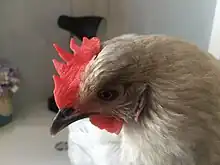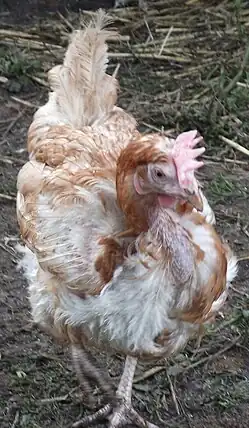Chicken
The chicken (Gallus domesticus) is a domesticated species that arose from the red junglefowl, originally from Southeast Asia. They have also partially hybridized with other wild species of junglefowl (the grey junglefowl, Ceylon junglefowl, and green junglefowl).[1] Rooster and cock are terms for adult male birds, and a younger male may be called a cockerel. A male that has been castrated is a capon. An adult female bird is called a hen, and a sexually immature female is called a pullet. Humans keep chickens primarily as a source of food (consuming both their meat and eggs) or as pets. Traditionally, they were also bred for cockfighting, which is still practiced in some places. Chickens domesticated for meat are broilers, and for eggs, they are layers.
| Chicken | |
|---|---|
 | |
| A rooster (left) and hen (right) perching on a roost | |
Domesticated | |
| Scientific classification | |
| Domain: | Eukaryota |
| Kingdom: | Animalia |
| Phylum: | Chordata |
| Clade: | Dinosauria |
| Class: | Aves |
| Order: | Galliformes |
| Family: | Phasianidae |
| Genus: | Gallus |
| Species: | G. domesticus |
| Binomial name | |
| Gallus domesticus | |
_chickens.tif.jpg.webp) | |
| Chicken distribution | |
Chickens are one of the most common and widespread domestic animals, with a total population of 23.7 billion as of 2018,[2] up from more than 19 billion in 2011. There are more chickens in the world than any other bird. There are numerous cultural references to chickens—in myth, folklore, and religion, as well as in language and literature.
Genetic studies have pointed to multiple maternal origin theories within South Asia, Southeast Asia, and East Asia,[3] but the clade found in the Americas, Europe, the Middle East, and Africa originated from the Indian subcontinent. From ancient India, the chicken spread to the Eastern Mediterranean. They appear in ancient Egypt in the mid-15th century BC, with the "bird that gives birth every day" having come from the land between Syria and Shinar, Babylonia, according to the annals of Thutmose III.[4][5][6] They are known in ancient Greece from the 5th century BC.[7][8]
Terminology
An adult male is a called a cock or (in the United States) a rooster, and an adult female is called a hen.[9][10]
Other terms are:
- Biddy: a newly hatched chicken[11][12]
- Capon: a castrated or neutered male chicken[lower-alpha 1]
- Chick: a young chicken[13]
- Chook /tʃʊk/: a chicken (Australia/New Zealand, informal)[14]
- Cockerel: a young male chicken less than a year old[15]
- Dunghill fowl: a chicken with mixed parentage from different domestic varieties.[16]
- Pullet: a young female chicken less than a year old.[17] In the poultry industry, a pullet is a sexually immature chicken less than 22 weeks of age.[18]
- Yardbird: a chicken (southern United States, dialectal)[19]
Chicken may also mean a chick .[20] In fact, chicken was originally a term only for an immature, or at least young, bird. In older sources, and still often in trade and scientific contexts, chicken as a species are typically referred to as common fowl or domestic fowl.[21]
In Australian vernacular English the word chook provides the generic term for the species (e.g. "a cooked chook" or "she keeps chooks"); which enables chicken to commonly retain its original sense of a young or recently hatched bird. Chick is then rarely used to mean chicken, but is mainly used in Merriam-Webster's "Sense 1b" viz. the young of any bird.
Etymology
According to Merriam-Webster, the term rooster (i.e., a roosting bird) originated in the mid- or late 18th century as a euphemism to avoid the sexual connotation of the original English cock,[22][23][24] and is widely used throughout North America. Roosting is the action of perching aloft to sleep at night.[25]
Biology and habitat
Chickens are omnivores.[26] In the wild, they often scratch at the soil to search for seeds, insects, and even animals as large as lizards, small snakes,[27] or sometimes young mice.[28]
The average chicken may live for 5–10 years, depending on the breed.[29] The world's oldest known chicken lived for 16 years, according to Guinness World Records.[30]
Roosters can usually be differentiated from hens by their striking plumage of long, flowing tails and shiny, pointed feathers on their necks (hackles) and backs (saddle), which are typically of brighter, bolder colours than those of females of the same breed. However, in some breeds, such as the Sebright chicken, the rooster has only slightly pointed neck feathers, the same colour as the hen's. Identification can be made by looking at the comb, or eventually by the development of spurs on the male's legs (in a few breeds and in certain hybrids, the male and female chicks may be differentiated by colour).
Adult chickens have a fleshy crest on their heads called a comb, or cockscomb, and hanging flaps of skin on either side under their beaks called wattles. Collectively, these and other fleshy protuberances on the head and throat are called caruncles. Both the adult male and female have wattles and combs, but in most breeds, these are more prominent in males. A 'muff' or 'beard' is a mutation found in several chicken breeds that causes extra feathering under the chicken's face, giving the appearance of a beard.[31]
Domestic chickens are not capable of long-distance flight, although lighter chickens are generally capable of flying for short distances, such as over fences or into trees (where they would naturally roost). Chickens may occasionally fly briefly to explore their surroundings, but generally do so only to flee perceived danger.
Social behaviour
.jpg.webp)
Chickens are gregarious birds and live together in flocks. They have a communal approach to the incubation of eggs and raising of young. Individual chickens in a flock will dominate others, establishing a pecking order, with dominant individuals having priority for food access and nesting locations. Removing hens or roosters from a flock causes a temporary disruption to this social order until a new pecking order is established. Adding hens, especially younger birds, to an existing flock can lead to fighting and injury.
Chickens may occasionally gang up on a weak or inexperienced predator. At least one credible report exists of a young fox killed by hens.[32][33][34] If a chicken is threatened by predators, stress, or is sick, it may puff up its feathers.[35]
Vocalizations
When a rooster finds food, he may call other chickens to eat first. He does this by clucking in a high pitch as well as picking up and dropping the food. This behaviour may also be observed in mother hens to call their chicks and encourage them to eat.
A rooster's crowing is a loud and sometimes shrill call and sends a territorial signal to other roosters.[36] However, roosters may also crow in response to sudden disturbances within their surroundings.
Hens cluck loudly after laying an egg and also to call their chicks. Chickens also give different warning calls when they sense a predator approaching from the air or on the ground.[37]
Crowing

Roosters almost always start crowing before four months of age. Although it is possible for a hen to crow as well, crowing (together with hackles development) is one of the clearest signs of being a rooster.
Rooster crowing contests are a traditional sport in several countries, such as Germany, the Netherlands, Belgium,[38] the United States, Indonesia and Japan. The oldest contests are held with longcrowers. Depending on the breed, either the duration of the crowing or the times the rooster crows within a certain time is measured.
Courtship
To initiate courting, some roosters may dance in a circle around or near a hen (a circle dance), often lowering the wing which is closest to the hen.[39] The dance triggers a response in the hen[39] and when she responds to his call, the rooster may mount the hen and proceed with the mating.
More specifically, mating typically involves the following sequence:
- Male approaching the hen
- Male pre-copulatory waltzing
- Male waltzing
- Female crouching (receptive posture) or stepping aside or running away (if unwilling to copulate)
- Male mounting
- Male treading with both feet on hen's back
- Male tail bending (following successful copulation)[40]
Nesting and laying behaviour
Hens will often try to lay in nests that already contain eggs and have been known to move eggs from neighbouring nests into their own. The result of this behaviour is that a flock will use only a few preferred locations, rather than having a different nest for every bird. Hens will often express a preference to lay in the same location. Two or more hens may try to share the same nest at the same time. If the nest is small or one of the hens is particularly determined, this may result in chickens trying to lay on top of each other. There is evidence that individual hens prefer to be either solitary or gregarious nesters.[41]
Broodiness
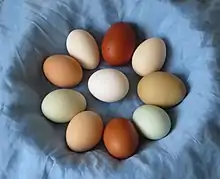
Under natural conditions, most birds lay only until a clutch is complete and they will then incubate all the eggs. Hens are then said to "go broody". The broody hen will stop laying and instead will focus on the incubation of the eggs (a full clutch is usually about 12 eggs). She will sit or 'set' on the nest, fluffing up or pecking in defense if disturbed or removed. The hen will rarely leave the nest to eat, drink, or dust-bathe.[35] While brooding, the hen maintains the nest at a constant temperature and humidity, as well as turning the eggs regularly during the first part of the incubation. To stimulate broodiness, owners may place several artificial eggs in the nest. To discourage it, they may place the hen in an elevated cage with an open wire floor.
Breeds artificially developed for egg production rarely go broody, and those that do often stop part-way through the incubation. However, other breeds, such as the Cochin, Cornish and Silkie, do regularly go broody, and make excellent mothers, not only for chicken eggs but also for those of other species — even those with much smaller or larger eggs and different incubation periods, such as quail, pheasants, ducks, turkeys, or geese.
Hatching and early life
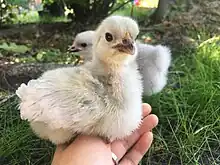
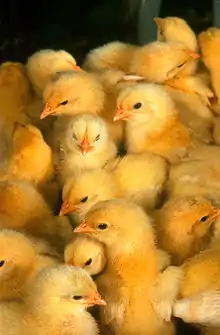
Fertile chicken eggs hatch at the end of the incubation period, about 21 days.[39] Development of the chick starts only when incubation begins, so all chicks hatch within a day or two of each other, despite perhaps being laid over a period of two weeks or so. Before hatching, the hen can hear the chicks peeping inside the eggs and will gently cluck to stimulate them to break out of their shells. The chick begins by pipping: pecking a breathing hole with its egg tooth towards the blunt end of the egg, usually on the upper side. The chick then rests for some hours, absorbing the remaining egg yolk and withdrawing the blood supply from the membrane beneath the shell (used earlier for breathing through the shell). The chick then enlarges the hole, gradually turning round as it goes, and eventually severing the blunt end of the shell completely to make a lid. The chick crawls out of the remaining shell, and the wet down dries out in the warmth of the nest.
Hens usually remain on the nest for about two days after the first chick hatches, and during this time the newly hatched chicks feed by absorbing the internal yolk sac. Some breeds sometimes start eating cracked eggs, which can become habitual.[42] Hens fiercely guard their chicks and brood them when necessary to keep them warm, at first often returning to the nest at night. She leads them to food and water and will call them toward edible items but seldom feeds them directly. She continues to care for them until they are several weeks old.
Reproduction
Sperm transfer occurs by cloacal contact between the male and female, in a maneuver known as the 'cloacal kiss'.[43] As with birds in general, reproduction is controlled by a neuroendocrine system, the Gonadotropin-Releasing Hormone-I neurons in the hypothalamus. Locally to the reproductive system, reproductive hormones such as estrogen, progesterone, gonadotropins (luteinizing hormone and follicle-stimulating hormone) initiate and maintain sexual maturation changes. Over time there is reproductive decline, thought to be due to GnRH-I-N decline. Because there is significant inter-individual variability in egg-producing duration, it is believed to be possible to breed for further extended useful lifetime in egg-layers.[44]
Embryology
Chicken embryos have long been used as model organisms to study developing embryos. Large numbers of embryos can be provided by commercial chicken farmers who sell fertilized eggs which can be easily opened and used to observe the developing embryo. Equally important, embryologists can carry out experiments on such embryos, close the egg again and study the effect later on. For instance, many important discoveries in the area of limb development have been made using chicken embryos, such as the discovery of the apical ectodermal ridge and the zone of polarizing activity by John W. Saunders.[45]
In 2006, scientists researching the ancestry of birds "turned on" a chicken recessive gene, talpid2, and found that the embryo jaws initiated formation of teeth, like those found in ancient bird fossils. John Fallon, the overseer of the project, stated that chickens have "...retained the ability to make teeth, under certain conditions... ."[46]
Genetics and genomics

Given its eminent role in farming, meat production, but also research, the house chicken was the first bird genome to be sequenced.[47] At 1.21 Gb, the chicken genome is similarly sized compared to other birds, but smaller than nearly all mammals, such as the human genome (of 3.2 Gb).[48] The final gene set contained 26,640 genes (including noncoding genes and pseudogenes), with a total of 19,119 protein-coding genes in annotation release 103 (2017), a similar number of protein-coding genes as in the human genome.[49]
Physiology
Populations of chickens from high-altitude regions like Tibet have special physiological adaptations that result in a higher hatching rate in low oxygen environments. When eggs are placed in a hypoxic environment, chicken embryos from these populations express much more hemoglobin than embryos from other chicken populations. This hemoglobin also has a greater affinity for oxygen, allowing hemoglobin to bind to oxygen more readily.[50]
Pinopsins were originally discovered in the chicken pineal gland.[51]
Although all avians appear to have lost TLR9, artificial immunity against bacterial pathogens has been induced in neonatal chicks by Taghavi et al. 2008 using tailored oligodeoxynucleotides.[52]
Origin and dispersal
Origin
Galliformes, the order of bird that chickens belong to, is directly linked to the survival of birds when all other dinosaurs went extinct. Water or ground-dwelling fowl, similar to modern partridges, survived the Cretaceous–Paleogene extinction event that killed all tree-dwelling birds and dinosaurs.[53] Some of these evolved into the modern galliformes, of which domesticated chickens are a main model. They are descended primarily from the red junglefowl (Gallus gallus) and are scientifically classified as the same species.[54] As such, domesticated chickens can and do freely interbreed with populations of red junglefowl.[54] Subsequent hybridization of the domestic chicken with grey junglefowl, Sri Lankan junglefowl and green junglefowl occurred;[55] a gene for yellow skin, for instance, was incorporated into domestic birds through hybridization with the grey junglefowl (G. sonneratii).[56] In a study published in 2020, it was found that chickens shared between 71–79% of their genome with red junglefowl, with the period of domestication dated to 8,000 years ago.[55]
Domestication
According to one early study, a single domestication event of the red junglefowl in present-day Thailand gave rise to the modern chicken with minor transitions separating the modern breeds.[57] The red junglefowl is well adapted to take advantage of the vast quantities of seed produced during the end of the multi-decade bamboo seeding cycle, to boost its own reproduction.[58] In domesticating the chicken, humans took advantage of this predisposition for prolific reproduction of the red junglefowl when exposed to large amounts of food.[59]
Exactly when and where the chicken was domesticated remains a controversial issue. Genomic studies estimate that the chicken was domesticated 8,000 years ago[55] in Southeast Asia and spread to China and India 2,000 to 3,000 years later. Archaeological evidence supports domestic chickens in Southeast Asia well before 6000 BC, China by 6000 BC and India by 2000 BC.[55][60][61] A landmark 2020 Nature study that fully sequenced 863 chickens across the world suggests that all domestic chickens originate from a single domestication event of red junglefowl whose present-day distribution is predominantly in southwestern China, northern Thailand and Myanmar. These domesticated chickens spread across Southeast and South Asia where they interbred with local wild species of junglefowl, forming genetically and geographically distinct groups. Analysis of the most popular commercial breed shows that the White Leghorn breed possesses a mosaic of divergent ancestries inherited from subspecies of red junglefowl.[62][63][64]
Dispersal
_into_the_Pacific_via_the_Austronesian_migrations_(Thomson%252C_Lebrasseur%252C_%2526_Austin%252C_2014).png.webp)
A word for the domestic chicken (*manuk) is part of the reconstructed Proto-Austronesian language, indicating they were domesticated by the Austronesian peoples since ancient times. Chickens, together with dogs and pigs, were carried throughout the entire range of the prehistoric Austronesian maritime migrations to Island Southeast Asia, Micronesia, Island Melanesia, Polynesia, and Madagascar, starting from at least 3000 BC from Taiwan.[65][66][67][68] These chickens might have been introduced during pre-Columbian times to South America via Polynesian seafarers, but evidence for this is still putative.[69]
Middle Eastern chicken remains go back to a little earlier than 2000 BC in Syria. They reached Egypt for purposes of cockfighting about 1400 BC and became widely bred in Egypt around 300 BC.[70] Phoenicians spread chickens along the Mediterranean coasts as far as Iberia. During the Hellenistic period (4th–2nd centuries BC), in the southern Levant, chickens began to be widely domesticated for food.[71] This change occurred at least 100 years before domestication of chickens spread to Europe.
The first pictures of chickens in Europe are found on Corinthian pottery of the 7th century BC.[72][73]
Chickens reached Europe c. 100 BC.[74] Breeding increased under the Roman Empire and reduced by the Middle Ages.[70] Genetic sequencing of chicken bones from archaeological sites in Europe revealed that in the High Middle Ages chickens became less aggressive and began to lay eggs earlier in the breeding season.[75]
Three possible routes of introduction into Africa around the early first millennium AD could have been through the Egyptian Nile Valley, the East Africa Roman-Greek or Indian trade, or from Carthage and the Berbers, across the Sahara. The earliest known remains are from Mali, Nubia, East Coast, and South Africa and date back to the middle of the first millennium AD.[70]
Domestic chicken in the Americas before Western contact is still an ongoing discussion, but blue-egged chickens, found only in the Americas and Asia, suggest an Asian origin for early American chickens.[70] A lack of data from Thailand, Russia, the Indian subcontinent, Southeast Asia and Sub-Saharan Africa makes it difficult to lay out a clear map of the spread of chickens in these areas; better description and genetic analysis of local breeds threatened by extinction may also help with research into this area.[70]
South America
An unusual variety of chicken that has its origins in South America is the Araucana, bred in southern Chile by the Mapuche people. Araucanas lay blue-green eggs. Additionally, some Araucanas are tailless, and some have tufts of feathers around their ears. It has long been suggested that they pre-date the arrival of European chickens brought by the Spanish and are evidence of pre-Columbian trans-Pacific contacts between Asian or Pacific Oceanic peoples, particularly the Polynesians, and South America. In 2007, an international team of researchers reported the results of their analysis of chicken bones found on the Arauco Peninsula in south-central Chile. Radiocarbon dating suggested that the chickens were pre-Columbian, and DNA analysis showed that they were related to prehistoric populations of chickens in Polynesia.[76] These results appeared to confirm that the chickens came from Polynesia and that there were transpacific contacts between Polynesia and South America before Columbus' arrival in the Americas.[77][78]
However, a later report looking at the same specimens concluded:
A published, apparently pre-Columbian, Chilean specimen and six pre-European Polynesian specimens also cluster with the same European/Indian subcontinental/Southeast Asian sequences, providing no support for a Polynesian introduction of chickens to South America. In contrast, sequences from two archaeological sites on Easter Island group with an uncommon haplogroup from Indonesia, Japan, and China and may represent a genetic signature of an early Polynesian dispersal. Modeling of the potential marine carbon contribution to the Chilean archaeological specimen casts further doubt on claims for pre-Columbian chickens, and definitive proof will require further analyses of ancient DNA sequences and radiocarbon and stable isotope data from archaeological excavations within both Chile and Polynesia.[79]
The debate for and against a Polynesian origin for South American chickens continued with this 2014 paper and subsequent responses in PNAS.[80]
Use by humans
Farming
More than 50 billion chickens are reared annually as a source of meat and eggs.[82] In the United States alone, more than 8 billion chickens are slaughtered each year for meat,[83] and more than 300 million chickens are reared for egg production.[84] The vast majority of poultry is raised in factory farms. According to the Worldwatch Institute, 74% of the world's poultry meat and 68% of eggs are produced this way.[85] An alternative to intensive poultry farming is free-range farming.
Friction between these two main methods has led to long-term issues of ethical consumerism. Opponents of intensive farming argue that it harms the environment, creates human health risks and is inhumane.[86] Advocates of intensive farming say that their highly efficient systems save land and food resources owing to increased productivity, and that the animals are looked after in state-of-the-art environmentally controlled facilities.[87]
Reared for meat
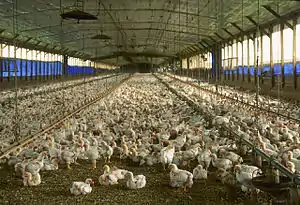
Chickens farmed for meat are called broilers. Chickens will naturally live for six or more years, but broiler breeds typically take less than six weeks to reach slaughter size.[88] A free range or organic broiler will usually be slaughtered at about 14 weeks of age.
Reared for eggs
Chickens farmed primarily for eggs are called layer hens. In total, the UK alone consumes more than 34 million eggs per day.[89] Some hen breeds can produce over 300 eggs per year, with the highest authenticated rate of egg laying being 371 eggs in 364 days.[90] After 12 months of laying, the commercial hen's egg-laying ability starts to decline to the point where the flock is commercially unviable. Hens, particularly from battery cage systems, are sometimes infirm or have lost a significant amount of their feathers, and their life expectancy has been reduced from around seven years to less than two years.[91]
In the UK and Europe, laying hens are then slaughtered and used in processed foods or sold as 'soup hens'.[91] In some other countries, flocks are sometimes force moulted rather than being slaughtered to re-invigorate egg-laying. This involves complete withdrawal of food (and sometimes water) for 7–14 days[92] or sufficiently long to cause a body weight loss of 25 to 35%,[93] or up to 28 days under experimental conditions.[94] This stimulates the hen to lose her feathers but also re-invigorates egg-production. Some flocks may be force-moulted several times. In 2003, more than 75% of all flocks were moulted in the US.[95]
As pets

Keeping chickens as pets became increasingly popular in the 2000s[96] among urban and suburban residents.[97] Many people obtain chickens for their egg production but often name them and treat them as any other pet like cats or dogs. Chickens provide companionship and have individual personalities. While many do not cuddle much, they will eat from one's hand, jump onto one's lap, respond to and follow their handlers, as well as show affection.[98][99]
Chickens are social, inquisitive, intelligent[100] birds, and many find their behaviour entertaining.[101] Certain breeds, such as silkies and many bantam varieties, are generally docile and are often recommended as good pets around children with disabilities.[102] Many people feed chickens in part with kitchen food scraps.

Cockfighting
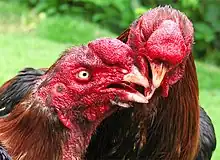
A cockfight is a contest held in a ring called a cockpit between two cocks known as gamecocks. This term, denoting a cock kept for game, sport, pastime or entertainment, appears in 1646,[104] after "cock of the game" used by George Wilson in the earliest known book on the secular sport, The Commendation of Cocks and Cock Fighting of 1607. Gamecocks are not typical farm chickens. The cocks are specially bred and trained for increased stamina and strength. The comb and wattle are removed from a young gamecock because if left intact, they would be a disadvantage during a match. This process is called dubbing. Sometimes the cocks are given drugs to increase their stamina or thicken their blood, which increases their chances of winning. Cockfighting is considered a traditional sporting event by some but an example of animal cruelty by others and is therefore outlawed in most countries.[105] Usually wagers are made on the outcome of the match, with the survivor or last bird standing declared winner.
Cocks possess congenital aggression toward other cocks to contest for females. Studies suggest that cockfights have existed even up to the Indus Valley civilisation as a pastime.[106] Today it is commonly associated with religious worship, pastime, and gambling in Asian and some South American countries. While not all fights are to the death, most use metal spurs as a weapon attached above or below the chicken's own spur, which typically results in death in one or both cocks. If chickens are in practice, owners place gloves on the spurs to prevent injuries.
Artificial incubation
Incubation can occur artificially in machines that provide the correct, controlled environment for the developing chick.[107][108] The average incubation period for chickens is 21 days, but the duration depends on the temperature and humidity in the incubator. Temperature regulation is the most critical factor for a successful hatch. Variations of more than 1 °C (1.8 °F) from the optimum temperature of 37.5 °C (99.5 °F) will reduce hatch rates. Humidity is also important because the rate at which eggs lose water by evaporation depends on the ambient relative humidity. Evaporation can be assessed by candling, to view the size of the air sac, or by measuring weight loss. Relative humidity should be increased to around 70% in the last three days of incubation to keep the membrane around the hatching chick from drying out after the chick cracks the shell. Lower humidity is usual in the first 18 days to ensure adequate evaporation.
The position of the eggs in the incubator can also influence hatch rates. For best results, eggs should be placed with the pointed ends down and turned regularly (at least three times per day) until one to three days before hatching. If the eggs are not turned, the embryo inside may stick to the shell and may hatch with physical defects. Adequate ventilation is necessary to provide the embryo with oxygen. Older eggs require increased ventilation.
Many commercial incubators are industrial-sized with shelves holding tens of thousands of eggs at a time, with rotation of the eggs a fully automated process. Home incubators are boxes holding from 6 to 75 eggs.
Diseases and ailments
Chickens are susceptible to several parasites, including lice, mites, ticks, fleas, and intestinal worms, as well as other diseases. Despite the name, they are not affected by chickenpox, which is generally restricted to humans.[109] Chickens can carry and transmit salmonella in their dander and feces. In the United States, the Centers for Disease Control and Prevention advise against bringing them indoors or letting small children handle them.[110][111]
Some of the diseases that can affect chickens are shown below:
Impacts of climate change
.jpg.webp)
It is believed that the thermal comfort zone for poultry is in the 18–25 °C (64–77 °F) range. Some papers describe 26–35 °C (79–95 °F) as the "critical zone" for heat stress, but others report that due to acclimatization, birds in the tropical countries do not begin to experience heat stress until 32 °C (90 °F). There is wider agreement that temperatures greater than 35 °C (95 °F) and 47 °C (117 °F) form "upper critical" and lethal zones, respectively.[118] Average daily temperatures of around 33 °C (91 °F) are known to interfere with feeding in both broilers and egg hens, as well as lower their immune response, with outcomes such as reduced weight gain/egg production or greater incidence of salmonella infections, footpad dermatitis or meningitis. Persistent heat stress leads to oxidative stress in tissues, and harvested white meat ends up with a lower proportion of essential compounds like vitamin E, lutein and zeaxanthin, yet an increase in glucose and cholesterol. Multiple studies show that dietary supplementation with chromium can help to relieve these issues due to its antioxidative properties, particularly in combination with zinc or herbs like wood sorrel.[119][120][121][122][123][124] Resveratrol is another popular antioxidant administered to poultry for these reasons.[125] Though the effect of supplementation is limited, it is much cheaper than interventions to improve cooling or simply stock fewer birds, and so remains popular.[126] While the majority of literature on poultry heat stress and dietary supplementation focuses on chickens, similar findings were seen in Japanese quails, which eat less and gain less weight, suffer reduced fertility and hatch eggs of worse quality under heat stress, and also seem to benefit from mineral supplementation.[127][128][129]
Around 2003 it was estimated that the poultry industry in the United States already lost up to $165 million annually due to heat stress at the time.[118] One paper estimated that if global warming reaches 2.5 °C (4.5 °F), then the cost of rearing broilers in Brazil increases by 35.8% at the least modernized farms and by 42.3% at farms with the medium level of technology used in livestock housing, while they increase the least at farms with the most advanced cooling technologies. On the contrary, if the warming is kept to 1.5 °C (2.7 °F), costs at moderately modernized farms increase the least, by 12.5%, followed by the most modernized farms with a 19.9% increase, and the least technological farms seeing the greatest increase.[130]Gallery

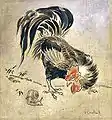 Joseph Crawhall III, Spanish Cock and Snail
Joseph Crawhall III, Spanish Cock and Snail Rooster and hen – Vietnamese Đông Hồ painting
Rooster and hen – Vietnamese Đông Hồ painting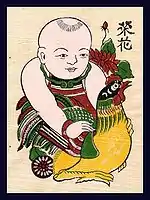 Vinh hoa, Đông Hồ painting, Vietnam
Vinh hoa, Đông Hồ painting, Vietnam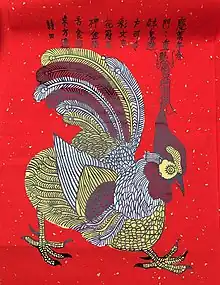 Thần kê, Kim Hoàng painting, Vietnam
Thần kê, Kim Hoàng painting, Vietnam
Notes
- The surgical and chemical castration of chickens is now illegal in some parts of the world.
References
-
- Lawal, Raman Akinyanju; Martin, Simon H.; Vanmechelen, Koen; Vereijken, Addie; Silva, Pradeepa; Al-Atiyat, Raed Mahmoud; Aljumaah, Riyadh Salah; Mwacharo, Joram M.; Wu, Dong-Dong; Zhang, Ya-Ping; Hocking, Paul M.; Smith, Jacqueline; Wragg, David; Hanotte, Olivier (February 12, 2020). "The wild species genome ancestry of domestic chickens". BMC Biology. BioMed Central. 18 (1): 13. doi:10.1186/s12915-020-0738-1. ISSN 1741-7007. PMC 7014787. PMID 32050971. S2CID 211081254.
- Tiley, George P.; Poelstra, Jelmer W.; dos Reis, Mario; Yang, Ziheng; Yoder, Anne D. (2020). "Molecular Clocks without Rocks: New Solutions for Old Problems". Trends in Genetics. Cell Press. 36 (11): 845–856. doi:10.1016/j.tig.2020.06.002. ISSN 0168-9525. PMID 32709458. S2CID 220747034. Archived from the original on June 11, 2022. Retrieved April 11, 2022.
- Tregaskes, Clive A.; Kaufman, Jim (2021). "Chickens as a simple system for scientific discovery: The example of the MHC". Molecular Immunology. Elsevier. 135: 12–20. doi:10.1016/j.molimm.2021.03.019. ISSN 0161-5890. PMC 7611830. PMID 33845329. S2CID 233223219. EuroPMC manus. 136199.
- Lawal, R. A.; Hanotte, O. (May 31, 2021). "Domestic chicken diversity: Origin, distribution, and adaptation". Animal Genetics. International Foundation for Animal Genetics (Wiley). 52 (4): 385–394. doi:10.1111/age.13091. ISSN 0268-9146. PMID 34060099. S2CID 235268576.
- Siegel, Paul B.; Honaker, Christa F.; Scanes, Colin G. (2022). "Domestication of poultry". Sturkie's Avian Physiology. Elsevier. pp. 109–120. doi:10.1016/b978-0-12-819770-7.00026-8. ISBN 978-0-12-819770-7. S2CID 244084328.
- Eda, Masaki (May 1, 2021). "Origin of the domestic chicken from modern biological and zooarchaeological approaches". Animal Frontiers. American Society of Animal Science (OUP). 11 (3): 52–61. doi:10.1093/af/vfab016. ISSN 2160-6056. PMC 8214436. PMID 34158989. S2CID 235593797.
- van Grouw, Hein; Dekkers, Wim (September 21, 2020). "Temminck's Gallus giganteus; a gigantic obstacle to Darwin's theory of domesticated fowl origin?". Bulletin of the British Ornithologists' Club. British Ornithologists' Club. 140 (3). doi:10.25226/bboc.v140i3.2020.a5. ISSN 0007-1595. S2CID 221823963.
- "Number of chickens worldwide from 1990 to 2018". Statista. Archived from the original on November 27, 2020. Retrieved February 23, 2020.
- Xiang, Hai; Gao, Jianqiang; Yu, Baoquan; Zhou, Hui; Cai, Dawei; Zhang, Youwen; Chen, Xiaoyong; Wang, Xi; Hofreiter, Michael; Zhao, Xingbo (December 9, 2014). "Early Holocene chicken domestication in northern China". Proceedings of the National Academy of Sciences. 111 (49): 17564–17569. Bibcode:2014PNAS..11117564X. doi:10.1073/pnas.1411882111. PMC 4267363. PMID 25422439.
- Carter, Howard (April 1923). "An Ostracon Depicting a Red Jungle-Fowl (The Earliest Known Drawing of the Domestic Cock)". The Journal of Egyptian Archaeology. 9 (1/2): 1–4. doi:10.2307/3853489. JSTOR 3853489.
- Pritchard, Earl H. "The Asiatic Campaigns of Thutmose III". Ancient Near East Texts related to the Old Testament. p. 240.
- Roehrig, Catharine H.; Dreyfus, Renée; Keller, Cathleen A. (2005). Hatshepsut: From Queen to Pharaoh. New York: Metropolitan Museum of Art. p. 268. ISBN 978-1-58839-173-5. Retrieved November 26, 2015.
- Toussaint-Samat, Maguelonne (2009). "11: The History of Poultry". The History of Food. Translated by Bell, Anthea (revised ed.). Blackwell. p. 306. ISBN 978-0631177418.
- Perry-Gal, Lee; Erlich, Adi; Gilboa, Ayelet; Bar-Oz, Guy (August 11, 2015). "Earliest economic exploitation of chicken outside East Asia: Evidence from the Hellenistic Southern Levant". Proceedings of the National Academy of Sciences. 112 (32): 9849–9854. Bibcode:2015PNAS..112.9849P. doi:10.1073/pnas.1504236112. PMC 4538678. PMID 26195775.
- "Cock". Cambridge Dictionary. Archived from the original on September 7, 2015. Retrieved March 4, 2021.
- "Hen". Cambridge Dictionary. Archived from the original on September 7, 2015. Retrieved March 4, 2021.
- "Definition of biddy | Dictionary.com". www.dictionary.com. Archived from the original on May 7, 2021. Retrieved May 7, 2021.
- "Biddy definition and meaning | Collins English Dictionary". www.collinsdictionary.com. Archived from the original on May 7, 2021. Retrieved May 7, 2021.
- "Chick". Cambridge Dictionary. Archived from the original on September 7, 2015.
- "Chook". Cambridge Dictionary. Archived from the original on September 7, 2015. Retrieved March 4, 2021.
- Cockerel. Dictionary.reference.com. Archived from the original on March 7, 2016. Retrieved August 29, 2010.
- Richardson, H. D. (1847). Domestic fowl: their natural history, breeding, rearing, and general management. Archived from the original on June 11, 2022. Retrieved March 30, 2022.
- Pullet. Dictionary.reference.com. Archived from the original on November 9, 2010. Retrieved August 29, 2010.
- "Overview of the Poultry Industry" (PDF). Overview of the Poultry Industry. Missouri Department of Elementary and Secondary Education. p. 8. Archived (PDF) from the original on October 23, 2020.
- Berhardt, Clyde E. B. (1986). I Remember: Eighty Years of Black Entertainment, Big Bands. Philadelphia: University of Pennsylvania Press. p. 153. ISBN 978-0-8122-8018-0. OCLC 12805260.
- "Chicken". Merriam Webster Dictionary. Archived from the original on August 21, 2008. Retrieved March 4, 2021.
- Stevens, Lewis, Genetics and evolution of the domestic fowl, p 1 and throughout, 1991, Cambridge University Press, google books
- "Definition of ROOSTER". www.merriam-webster.com. Archived from the original on April 22, 2021. Retrieved March 6, 2021.
- Hugh Rawson Archived July 1, 2017, at the Wayback Machine "Why Do We Say...? Rooster", American Heritage, August–September 2006.
- Online Etymology Dictionary Archived November 11, 2020, at the Wayback Machine Entry for rooster (n.), May 2019
- "Definition of ROOST". Collins English Dictionary. Archived from the original on May 1, 2021. Retrieved October 16, 2021.
- "Info on Chicken Care". Ideas-4-pets.co.uk. 2003. Archived from the original on June 25, 2015. Retrieved August 13, 2008.
- D Lines (July 27, 2013). "Chicken Kills Rattlesnake". YouTube. Archived from the original on December 11, 2021. Retrieved March 13, 2019.
- Gerard P.Worrell AKA "Farmer Jerry". "Frequently asked questions about chickens & eggs". Gworrell.freeyellow.com. Archived from the original on September 16, 2008. Retrieved August 13, 2008.
- "The Poultry Guide – A to Z and FAQs". Ruleworks.co.uk. Archived from the original on November 28, 2010. Retrieved August 29, 2010.
- Smith, Jamon (August 6, 2006). "World's oldest chicken starred in magic shows, was on 'Tonight Show'". Tuscaloosa News. Alabama, USA. Archived from the original on February 20, 2019. Retrieved May 18, 2020.
- Ying Guo, Xiaorong Gu, Zheya Sheng, Yanqiang Wang, Chenglong Luo, Ranran Liu, Hao Qu, Dingming Shu, Jie Wen, Richard P. M. A. Crooijmans, Örjan Carlborg, Yiqiang Zhao, Xiaoxiang Hu, Ning Li (2016). A Complex Structural Variation on Chromosome 27 Leads to the Ectopic Expression of HOXB8 and the Muffs and Beard Phenotype in Chickens Archived November 5, 2021, at the Wayback Machine. PLoS Genetics. 12 (6): e1006071. doi:10.1371/journal.pgen.1006071.
- "Chickens team up to 'peck fox to death'". The Independent. March 13, 2019. Archived from the original on March 15, 2019. Retrieved March 13, 2019.
- "Chickens 'gang up' to kill fox". Bbc.co.uk. March 13, 2019. Archived from the original on March 14, 2019. Retrieved March 13, 2019.
- AFP (March 12, 2019). "Chickens 'teamed up to kill fox' at Brittany farming school". Theguardian.com. Archived from the original on March 13, 2019. Retrieved March 13, 2019.
- "Why Do Chickens Puff up Their Feathers? I 4 Reasons Explained". August 8, 2020. Archived from the original on June 18, 2021. Retrieved June 16, 2021.
- "Top cock: Roosters crow in pecking order". Archived from the original on January 15, 2018. Retrieved January 14, 2018.
- Evans, Christopher S.; Evans, Linda; Marler, Peter (July 1993). "On the meaning of alarm calls: functional reference in an avian vocal system". Animal Behaviour. 46 (1): 23–38. doi:10.1006/anbe.1993.1158. S2CID 53165305.
- Cock crowing contest recognised as National Heritage in Belgium Archived November 23, 2020, at the Wayback Machine Stefaan De Groote, Het Nieuwsblad, 27. June 2011 (in Dutch). Accessed October 2015
- Grandin, Temple; Johnson, Catherine (2005). Animals in Translation. New York City: Scribner. pp. 69–71. ISBN 978-0-7432-4769-6.
- Cheng, Kimberly M.; Burns, Jeffrey T. (August 1988). "Dominance Relationship and Mating Behavior of Domestic Cocks: A Model to Study Mate-Guarding and Sperm Competition in Birds". The Condor. 90 (3): 697–704. doi:10.2307/1368360. JSTOR 1368360.
- Sherwin, C.M.; Nicol, C.J. (1993). "Factors influencing floor-laying by hens in modified cages". Applied Animal Behaviour Science. 36 (2–3): 211–222. doi:10.1016/0168-1591(93)90011-d.
- Ali, A.; Cheng, K.M. (1985). "Early egg production in genetically blind (rc/rc) chickens in comparison with sighted (Rc+/rc) controls". Poultry Science. 64 (5): 789–794. doi:10.3382/ps.0640789. PMID 4001066.
- Briskie, J. V.; R. Montgomerie (1997). "Sexual Selection and the Intromittent Organ of Birds". Journal of Avian Biology. 28 (1): 73–86. doi:10.2307/3677097. JSTOR 3677097.
- Bain, M. M.; Nys, Y.; Dunn, I.C. (May 3, 2016). "Increasing persistency in lay and stabilising egg quality in longer laying cycles. What are the challenges?". British Poultry Science. Taylor & Francis. 57 (3): 330–338. doi:10.1080/00071668.2016.1161727. ISSN 0007-1668. PMC 4940894. PMID 26982003. S2CID 17842329.
- Young, John J.; Tabin, Clifford J. (September 2017). "Saunders's framework for understanding limb development as a platform for investigating limb evolution". Developmental Biology. 429 (2): 401–408. doi:10.1016/j.ydbio.2016.11.005. PMC 5426996. PMID 27840200.
- Scientists Find Chickens Retain Ancient Ability to Grow Teeth Archived June 20, 2008, at the Wayback Machine Ammu Kannampilly, ABC News, February 27, 2006. Retrieved October 1, 2007.
- International Chicken Genome Sequencing Consortium (December 9, 2004). "Sequence and comparative analysis of the chicken genome provide unique perspectives on vertebrate evolution". Nature. 432 (7018): 695–716. Bibcode:2004Natur.432..695C. doi:10.1038/nature03154. PMID 15592404.
- Gregory, T. Ryan (September 2005). "Synergy between sequence and size in Large-scale genomics". Nature Reviews Genetics. 6 (9): 699–708. doi:10.1038/nrg1674.
- Warren, Wesley C.; Hillier, LaDeana W.; Tomlinson, Chad; Minx, Patrick; Kremitzki, Milinn; Graves, Tina; Markovic, Chris; Bouk, Nathan; Pruitt, Kim D.; Thibaud-Nissen, Francoise; Schneider, Valerie; Mansour, Tamer A.; Brown, C. Titus; Zimin, Aleksey; Hawken, Rachel; Abrahamsen, Mitch; Pyrkosz, Alexis B.; Morisson, Mireille; Fillon, Valerie; Vignal, Alain; Chow, William; Howe, Kerstin; Fulton, Janet E.; Miller, Marcia M.; Lovell, Peter; Mello, Claudio V.; Wirthlin, Morgan; Mason, Andrew S.; Kuo, Richard; Burt, David W.; Dodgson, Jerry B.; Cheng, Hans H. (January 2017). "A New Chicken Genome Assembly Provides Insight into Avian Genome Structure". G3. 7 (1): 109–117. doi:10.1534/g3.116.035923. PMC 5217101. PMID 27852011.
- Zhang, H.; Wang, X.T.; Chamba, Y.; Ling, Y.; Wu, C.X. (October 2008). "Influences of Hypoxia on Hatching Performance in Chickens with Different Genetic Adaptation to High Altitude". Poultry Science. 87 (10): 2112–2116. doi:10.3382/ps.2008-00122. ISSN 0032-5791. PMID 18809874.
- Nakane, Yusuke; Yoshimura, Takashi (February 15, 2019). "Photoperiodic Regulation of Reproduction in Vertebrates". Annual Review of Animal Biosciences. Annual Reviews. 7 (1): 173–194. doi:10.1146/annurev-animal-020518-115216. ISSN 2165-8102. PMID 30332291. S2CID 52984435.
- Brownlie, Robert; Allan, Brenda (September 1, 2010). "Avian toll-like receptors". Cell and Tissue Research. Springer. 343 (1): 121–130. doi:10.1007/s00441-010-1026-0. ISSN 0302-766X. PMID 20809414. S2CID 2877905.
- Pennisi, Elizabeth (May 24, 2018). "Quaillike creatures were the only birds to survive the dinosaur-killing asteroid impact". Science. doi:10.1126/science.aau2802.
- Wong, G. K.; Liu, B.; Wang, J.; Zhang, Y.; Yang, X.; Zhang, Z.; Meng, Q.; Zhou, J.; Li, D.; Zhang, J.; Ni, P.; Li, S.; Ran, L.; Li, H.; Zhang, J.; Li, R.; Li, S.; Zheng, H.; Lin, W.; Li, G.; Wang, X.; Zhao, W.; Li, J.; Ye, C.; Dai, M.; Ruan, J.; Zhou, Y.; Li, Y.; He, X.; et al. (December 9, 2004). "A genetic variation map for chicken with 2.8 million single nucleotide polymorphisms". Nature. 432 (7018): 717–722. Bibcode:2004Natur.432..717B. doi:10.1038/nature03156. PMC 2263125. PMID 15592405.
- Lawal, Raman Akinyanju; Martin, Simon H.; Vanmechelen, Koen; Vereijken, Addie; Silva, Pradeepa; Al-Atiyat, Raed Mahmoud; Aljumaah, Riyadh Salah; Mwacharo, Joram M.; Wu, Dong-Dong; Zhang, Ya-Ping; Hocking, Paul M.; Smith, Jacqueline; Wragg, David; Hanotte, Olivier (December 2020). "The wild species genome ancestry of domestic chickens". BMC Biology. 18 (1): 13. doi:10.1186/s12915-020-0738-1. PMC 7014787. PMID 32050971.
- Eriksson, Jonas; Larson, Greger; Gunnarsson, Ulrika; Bed'hom, Bertrand; Tixier-Boichard, Michele; Strömstedt, Lina; Wright, Dominic; Jungerius, Annemieke; Vereijken, Addie; Randi, Ettore; Jensen, Per; Andersson, Leif (February 29, 2008). "Identification of the Yellow Skin Gene Reveals a Hybrid Origin of the Domestic Chicken". PLOS Genetics. 4 (2): e1000010. doi:10.1371/journal.pgen.1000010. PMC 2265484. PMID 18454198.
- Fumihito, A; Miyake, T; Sumi, S; Takada, M; Ohno, S; Kondo, N (December 20, 1994), "One subspecies of the red junglefowl (Gallus gallus gallus) suffices as the matriarchic ancestor of all domestic breeds", PNAS, 91 (26): 12505–12509, Bibcode:1994PNAS...9112505F, doi:10.1073/pnas.91.26.12505, PMC 45467, PMID 7809067
- King, Rick (February 24, 2009), "Rat Attack", NOVA and National Geographic Television, archived from the original on August 23, 2017, retrieved August 25, 2017
- King, Rick (February 1, 2009), "Plant vs. Predator", NOVA, archived from the original on August 21, 2017, retrieved August 25, 2017
- West, B.; Zhou, B.X. (1988). "Did chickens go north? New evidence for domestication". J. Archaeol. Sci. 14 (5): 515–533. doi:10.1016/0305-4403(88)90080-5.
- Al-Nasser, A.; Al-Khalaifa, H.; Al-Saffar, A.; Khalil, F.; Albahouh, M.; Ragheb, G.; Al-Haddad, A.; Mashaly, M. (June 1, 2007). "Overview of chicken taxonomy and domestication". World's Poultry Science Journal. 63 (2): 285–300. doi:10.1017/S004393390700147X. S2CID 86734013.
- Wang, Ming-Shan; et al. (2020). "863 genomes reveal the origin and domestication of chicken". Cell Research. 30 (8): 693–701. doi:10.1038/s41422-020-0349-y. PMC 7395088. PMID 32581344. S2CID 220050312.
- Liu, Yi-Ping; Wu, Gui-Sheng; Yao, Yong-Gang; Miao, Yong-Wang; Luikart, Gordon; Baig, Mumtaz; Beja-Pereira, Albano; Ding, Zhao-Li; Palanichamy, Malliya Gounder; Zhang, Ya-Ping (January 2006). "Multiple maternal origins of chickens: Out of the Asian jungles". Molecular Phylogenetics and Evolution. 38 (1): 12–19. doi:10.1016/j.ympev.2005.09.014. PMID 16275023.
- Zeder, Melinda A.; Emshwiller, Eve; Smith, Bruce D.; Bradley, Daniel G. (March 2006). "Documenting domestication: the intersection of genetics and archaeology". Trends in Genetics. 22 (3): 139–155. doi:10.1016/j.tig.2006.01.007. PMID 16458995.
- Thomson, Vicki A.; Lebrasseur, Ophélie; Austin, Jeremy J.; Hunt, Terry L.; Burney, David A.; Denham, Tim; Rawlence, Nicolas J.; Wood, Jamie R.; Gongora, Jaime; Girdland Flink, Linus; Linderholm, Anna; Dobney, Keith; Larson, Greger; Cooper, Alan (April 2014). "Using ancient DNA to study the origins and dispersal of ancestral Polynesian chickens across the Pacific". Proceedings of the National Academy of Sciences. 111 (13): 4826–4831. Bibcode:2014PNAS..111.4826T. doi:10.1073/pnas.1320412111. PMC 3977275. PMID 24639505.
- Piper, Philip J. (2017). "The Origins and Arrival of the Earliest Domestic Animals in Mainland and Island Southeast Asia: A Developing Story of Complexity". In Piper, Philip J.; Matsumura, Hirofumi; Bulbeck, David (eds.). New Perspectives in Southeast Asian and Pacific Prehistory. terra australis. Vol. 45. ANU Press. ISBN 9781760460945. Archived from the original on November 28, 2022. Retrieved May 5, 2023.
- Meleisea, Malama (March 25, 2004). The Cambridge History of the Pacific Islanders. Cambridge University Press. p. 56. ISBN 9780521003544. Archived from the original on September 13, 2016. Retrieved March 13, 2019 – via Google Books.
- Crawford, Michael H. (March 13, 2019). Anthropological Genetics: Theory, Methods and Applications. Cambridge University Press. p. 411. ISBN 9780521546973. Archived from the original on September 13, 2016. Retrieved March 13, 2019 – via Google Books.
- Neumann, Scott (March 18, 2014). "Study: The Chicken Didn't Cross The Pacific To South America". The Two Way. NPR. Archived from the original on May 5, 2023. Retrieved May 5, 2023.
- CHOF : The Cambridge History of Food, 2000, Cambridge University Press, vol.1, pp496-499
- Perry-Gal, Lee; Erlich, Adi; Gilboa, Ayelet; Bar-Oz, Guy (August 11, 2015). "Earliest economic exploitation of chicken outside East Asia: Evidence from the Hellenistic Southern Levant". Proceedings of the National Academy of Sciences. 112 (32): 9849–9854. Bibcode:2015PNAS..112.9849P. doi:10.1073/pnas.1504236112. PMC 4538678. PMID 26195775.
- Karayanis, Dean; Karayanis, Catherine (March 13, 2019). Regional Greek Cooking. Hippocrene Books. p. 176. ISBN 9780781811460. Archived from the original on September 13, 2016. Retrieved March 13, 2019 – via Google Books.
- Chiffolo, Anthony F.; Hesse, Rayner W. (March 13, 2019). Cooking with the Bible: Biblical Food, Feasts, and Lore. Greenwood Publishing Group. p. 207. ISBN 9780313334108. Archived from the original on September 13, 2016. Retrieved March 13, 2019 – via Google Books.
- Perry-Gal, L.; Erlich, A.; Gilboa, A.; Bar-Oz, G. (2015). "Earliest economic exploitation of chicken outside East Asia: Evidence from the Hellenistic Southern Levant". Proceedings of the National Academy of Sciences of the United States of America. 112 (32): 9849–9854. Bibcode:2015PNAS..112.9849P. doi:10.1073/pnas.1504236112. PMC 4538678. PMID 26195775. "We further argue that the earliest secure evidence for economic exploitation of chickens in Europe dates to the first century B.C.E. and therefore is predated by the finds in the Southern Levant by at least a century."
- Brown, Marley (September–October 2017). "Fast Food". Archaeology. 70 (5): 18. ISSN 0003-8113. Archived from the original on July 25, 2019. Retrieved July 25, 2019.
- Borrell, Brendan (June 1, 2007). "DNA reveals how the chicken crossed the sea". Nature. 447 (7145): 620–621. Bibcode:2007Natur.447R.620B. doi:10.1038/447620b. PMID 17554271. S2CID 4418786.
- Storey, A. A.; Ramirez, J. M.; Quiroz, D.; Burley, D. V.; Addison, D. J.; Walter, R.; Anderson, A. J.; Hunt, T. L.; Athens, J. S.; Huynen, L.; Matisoo-Smith, E. A. (June 19, 2007). "Radiocarbon and DNA evidence for a pre-Columbian introduction of Polynesian chickens to Chile". Proceedings of the National Academy of Sciences. 104 (25): 10335–10339. Bibcode:2007PNAS..10410335S. doi:10.1073/pnas.0703993104. PMC 1965514. PMID 17556540.
- Wilford, John Noble (June 5, 2007). "First Chickens in Americas Were Brought From Polynesia". The New York Times. Archived from the original on June 7, 2007.
- Gongora, Jaime; Rawlence, Nicolas J.; Mobegi, Victor A.; Jianlin, Han; Alcalde, Jose A.; Matus, Jose T.; Hanotte, Olivier; Moran, Chris; Austin, J.; Ulm, Sean; Anderson, Atholl; Larson, Greger; Cooper, Alan (2008). "Indo-European and Asian origins for Chilean and Pacific chickens revealed by mtDNA". PNAS. 105 (30): 10308–10313. Bibcode:2008PNAS..10510308G. doi:10.1073/pnas.0801991105. PMC 2492461. PMID 18663216.
- Thomson, Vicki A.; Lebrasseur, Ophélie; Austin, Jeremy J.; Hunt, Terry L.; Burney, David A.; Denham, Tim; Rawlence, Nicolas J.; Wood, Jamie R.; Gongora, Jaime; Girdland Flink, Linus; Linderholm, Anna; Dobney, Keith; Larson, Greger; Cooper, Alan (April 1, 2014). "Using ancient DNA to study the origins and dispersal of ancestral Polynesian chickens across the Pacific". Proceedings of the National Academy of Sciences. 111 (13): 4826–4831. Bibcode:2014PNAS..111.4826T. doi:10.1073/pnas.1320412111. PMC 3977275. PMID 24639505.
- Jones, E.K.M.; Prescott, N.B. (2000). "Visual cues used in the choice of mate by fowl and their potential importance for the breeder industry". World's Poultry Science Journal. 56 (2): 127–138. doi:10.1079/WPS20000010. S2CID 86481908.
- "About chickens | Compassion in World Farming". Ciwf.org.uk. Archived from the original on April 26, 2017. Retrieved April 25, 2017.
- Fereira, John. "Poultry Slaughter Annual Summary". usda.mannlib.cornell.edu. Archived from the original on April 26, 2017. Retrieved April 25, 2017.
- Fereira, John. "Chickens and Eggs Annual Summary". usda.mannlib.cornell.edu. Archived from the original on April 26, 2017. Retrieved April 25, 2017.
- "Towards Happier Meals In A Globalized World". World Watch Institute. Archived from the original on May 29, 2014. Retrieved May 29, 2014.
- Ilea, Ramona Cristina (April 2009). "Intensive Livestock Farming: Global Trends, Increased Environmental Concerns, and Ethical Solutions". Journal of Agricultural and Environmental Ethics. 22 (2): 153–167. doi:10.1007/s10806-008-9136-3. S2CID 154306257.
- Tilman, David; Cassman, Kenneth G.; Matson, Pamela A.; Naylor, Rosamond; Polasky, Stephen (August 2002). "Agricultural sustainability and intensive production practices". Nature. 418 (6898): 671–677. Bibcode:2002Natur.418..671T. doi:10.1038/nature01014. PMID 12167873. S2CID 3016610.
- "Broiler Chickens Fact Sheet // Animals Australia". Animalsaustralia.org. Archived from the original on July 12, 2010. Retrieved August 29, 2010.
- "UK Egg Industry Data | Official Egg Info". Egginfo.co.uk. Archived from the original on December 30, 2016. Retrieved April 25, 2017.
- Glenday, Craig (April 26, 2011). Guinness World Records 2011. Mass Market Paperback. p. 286. ISBN 978-0440423102.
- Browne, Anthony (March 10, 2002). "Ten weeks to live". The Guardian. London. Archived from the original on May 16, 2008. Retrieved April 28, 2010.
- Patwardhan, D.; King, A. (2011). "Review: feed withdrawal and non feed withdrawal moult". World's Poultry Science Journal. 67 (2): 253–268. doi:10.1017/s0043933911000286. S2CID 88353703.
- Webster, A.B. (2003). "Physiology and behavior of the hen during induced moult". Poultry Science. 82 (6): 992–1002. doi:10.1093/ps/82.6.992. PMID 12817455.
- Molino, A.B.; Garcia, E.A.; Berto, D.A.; Pelícia, K.; Silva, A.P.; Vercese, F. (2009). "The Effects of Alternative Forced-Molting Methods on The Performance and Egg Quality of Commercial Layers". Brazilian Journal of Poultry Science. 11 (2): 109–113. doi:10.1590/s1516-635x2009000200006.
- Yousaf, M.; Chaudhry, A.S. (March 1, 2008). "History, changing scenarios and future strategies to induce moulting in laying hens" (PDF). World's Poultry Science Journal. 64 (1): 65–75. doi:10.1017/s0043933907001729. S2CID 34761543. Archived (PDF) from the original on November 24, 2020. Retrieved October 23, 2020.
- Fly, Colin (July 27, 2007). "Some homeowners find chickens all the rage". Chicago Tribune.
- Pollack-Fusi, Mindy (December 16, 2004). "Cooped up in suburbia". Boston Globe. Archived from the original on March 4, 2016. Retrieved June 4, 2020.
- Kreilkamp, Ivan (November 25, 2020). "How Caring for Backyard Chickens Stretched My Emotional Muscles". The New York Times. Archived from the original on November 25, 2020.
- Boone, Lisa (August 27, 2017). "Chickens will become a beloved pet — just like the family dog". Los Angeles Times. Archived from the original on April 2, 2019. Retrieved April 3, 2019.
- Barras, Colin. "Despite what you might think, chickens are not stupid". www.bbc.com. Archived from the original on June 5, 2021. Retrieved September 6, 2020.
- United Poultry Concerns. "Providing a Good Home for Chickens". Archived from the original on June 5, 2009. Retrieved May 4, 2009.
- "Choosing Your Chickens". Clucks and Chooks. Archived from the original on July 30, 2009.
- "Is It Safe To Feed My Chickens Table Scraps?". The Happy Chicken Coop. October 21, 2021. Archived from the original on October 4, 2022. Retrieved October 5, 2022.
- gamecock – Merriam-Webster Online Dictionary Archived August 18, 2017, at the Wayback Machine – first use of word – 1646
- "Should cockfighting be outlawed in Oklahoma?". CNN. November 26, 2002. Archived from the original on June 19, 2009. Retrieved August 17, 2009.
- Sherman, David M. (2002). Tending Animals in the Global Village. Blackwell Publishing. 46. ISBN 0-683-18051-7.
- Joe G. Berry. "Artificial Incubation". Oklahoma Cooperative Extension Service, Oklahoma State University. Archived (PDF) from the original on June 4, 2010. Retrieved September 29, 2010.
- Phillip J. Clauer. "Incubating Eggs" (PDF). Virginia Cooperative Extension Service, Virginia State University. Archived (PDF) from the original on June 13, 2010. Retrieved October 1, 2010.
- White, Tiffany M.; Gilden, Donald H.; Mahalingam, Ravi (October 2001). "An Animal Model of Varicella Virus Infection". Brain Pathology. 11 (4): 475–479. doi:10.1111/j.1750-3639.2001.tb00416.x. PMC 8098339. PMID 11556693. S2CID 26073177.
- "Forget dogs and cats. The most pampered pets of the moment might be our backyard chickens". USA TODAY. Archived from the original on April 3, 2019. Retrieved April 3, 2019.
- CDC (March 18, 2019). "Keeping Backyard Poultry". Centers for Disease Control and Prevention. Archived from the original on April 1, 2019. Retrieved April 3, 2019.
- "Crop bound". Archived from the original on October 26, 2010.
- "Infectious Bronchitis Virus: Classical and Variant Strains". Archived from the original on October 5, 2021. Retrieved June 11, 2022.
- "Necrotic Enteritis". Archived from the original on December 16, 2010.
- "Overview of Omphalitis in Poultry". Merck Veterinary Manual. Archived from the original on January 13, 2017. Retrieved January 10, 2017.
- "Clucks and Chooks: guide to keeping chickens". Henkeeping.co.uk. Archived from the original on January 15, 2010. Retrieved October 26, 2009.
- "Merck Veterinary Manual". Archived from the original on March 11, 2007. Retrieved January 10, 2007.
- Oladokun, Samson; Adewole, Deborah I. (October 1, 2022). "Biomarkers of heat stress and mechanism of heat stress response in Avian species: Current insights and future perspectives from poultry science". Journal of Thermal Biology. 110: 103332. doi:10.1016/j.jtherbio.2022.103332. PMID 36462852. S2CID 252361675.
- Alhenaky, Alhanof; Abdelqader, Anas; Abuajamieh, Mohannad; Al-Fataftah, Abdur-Rahman (November 3, 2017). "The effect of heat stress on intestinal integrity and Salmonella invasion in broiler birds". Journal of Thermal Biology. 70 (Pt B): 9–14. doi:10.1016/j.jtherbio.2017.10.015. PMID 29108563.
- Kuter, Eren; Cengiz, Özcan; Köksal, Bekir Hakan; Sevim, Ömer; Tatlı, Onur; Ahsan, Umair; Güven, Gülşen; Önol, Ahmet Gökhan; Bilgili, Sacit F. (December 28, 2022). "Litter quality and incidence and severity of footpad dermatitis in heat stressed broiler chickens fed supplemental zinc". Livestock Science. 267: 1491–1499. doi:10.1016/j.livsci.2022.105145. S2CID 254914487.
- Xu, Yongjie; Lai, Xiaodan; Li, Zhipeng; Zhang, Xiquan; Luo, Qingbin (November 1, 2018). "Effect of chronic heat stress on some physiological and immunological parameters in different breed of broilers". Poultry Science. 97 (11): 4073–4082. doi:10.3382/ps/pey256. PMC 6162357. PMID 29931080.
- Orhan, Cemal; Tuzcu, Mehmet; Deeh, Patrick Brice Defo; Sahin, Nurhan; Komorowski, James R.; Sahin, Kazim (August 21, 2018). "Organic Chromium Form Alleviates the Detrimental Effects of Heat Stress on Nutrient Digestibility and Nutrient Transporters in Laying Hens". Biological Trace Element Research. 189 (2): 529–537. doi:10.1007/s12011-018-1485-9. PMID 30132119. S2CID 255452740.
- Sahin, N; Hayirli, A; Orhan, C; Tuzcu, M; Akdemir, F; Komorowski, J R; Sahin, K (December 11, 2019). "Effects of the supplemental chromium form on performance and oxidative stress in broilers exposed to heat stress". Poultry Science. 96 (12): 4317–4324. doi:10.3382/ps/pex249. PMID 29053811. S2CID 10630678.
- Untea, Arabela Elena; Varzaru, Iulia; Turcu, Raluca Paula; Panaite, Tatiana Dumitra; Saracila, Mihaela (October 13, 2021). "The use of dietary chromium associated with vitamins and minerals (synthetic and natural source) to improve some quality aspects of broiler thigh meat reared under heat stress condition". Italian Journal of Animal Science. 20 (1): 1491–1499. doi:10.1080/1828051X.2021.1978335. S2CID 244583811.
- Ding, Kang-Ning; Lu, Meng-Han; Guo, Yan-Na; Liang, Shao-Shan; Mou, Rui-Wei; He, Yong-Ming He; Tang, Lu-Ping (December 14, 2022). "Resveratrol relieves chronic heat stress-induced liver oxidative damage in broilers by activating the Nrf2-Keap1 signaling pathway". Ecotoxicology and Environmental Safety. 249: 114411. doi:10.1016/j.ecoenv.2022.114411. PMID 36525949. S2CID 254723325.
- Sahin, K; Sahin, N; Kucuk, O; Hayirli, A; Prasad, A. S. (October 1, 2009). "Role of dietary zinc in heat-stressed poultry: A review". Poultry Science. 88 (10): 2176–2183. doi:10.3382/ps.2008-00560. PMID 19762873.
- El-Tarabany, Mahmoud S. (August 27, 2016). "Effect of thermal stress on fertility and egg quality of Japanese quail". Journal of Thermal Biology. 61: 38–43. doi:10.1016/j.jtherbio.2016.08.004. PMID 27712658.
- Bilal, Rana Muhammad; Hassan, Faiz-ul; Farag, Mayada R.; Nasir, Taquir Ali; Ragni, Marco; Ahsan, Umair; Güven, Gülşen (April 20, 2021). "Thermal stress and high stocking densities in poultry farms: Potential effects and mitigation strategies". Journal of Thermal Biology. 99: 102944. doi:10.1016/j.jtherbio.2021.102944. PMID 34420608. S2CID 233555119.
- Kucuk, O. (January 10, 2008). "Zinc in a Combination with Magnesium Helps Reducing Negative Effects of Heat Stress in Quails". Biological Trace Element Research. 123 (1–3): 144–153. doi:10.1007/s12011-007-8083-6. PMID 18188513. S2CID 24775551.
- de Carvalho Curi, T. M. R.; de Alencar Nääs, I.; da Silva Lima, N. D.; Martinez, A. A. G. (January 24, 2022). "Climate change impact on Brazilian broiler production cost: a simulation study". International Journal of Environmental Science and Technology. 19 (11): 10589–10598. doi:10.1007/s13762-021-03893-z. S2CID 246211499.
External links
 Media related to Chickens at Wikimedia Commons
Media related to Chickens at Wikimedia Commons The dictionary definition of cockerel at Wiktionary
The dictionary definition of cockerel at Wiktionary Data related to Gallus gallus domesticus at Wikispecies
Data related to Gallus gallus domesticus at Wikispecies

